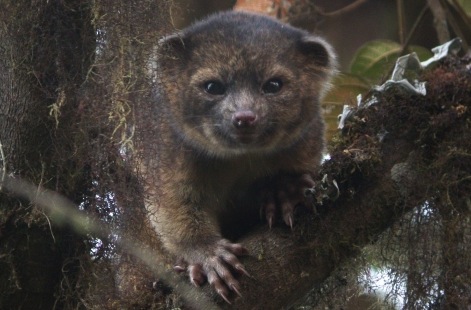For all of modern history, a small, carnivorous South American mammal in the raccoon family has evaded the scientific community. Untold thousands of these red, furry creatures scampered through the trees of the Andean cloud forests, but they did so at night, hidden by dense fog. Nearly two dozen preserved samples—mostly skulls or furs— were mislabeled in museum collections across the United States. There’s even evidence that one individual lived in several American zoos during the 1960s—its keepers were mystified as to why it refused to breed with its peers.
Bassaricyon is a genus, or family, of tree-living carnivore that includes several different species, while nebina means ‘fog’ in Spanish.
After identifying museum specimens, the researchers travelled to the northern Andes to see if any olinguitos remained in the wild.
Records showed that the creature lived high in the mountains, at elevations of 5,000 to 9,000 feet above sea level and grainy footage from a camcorder video provided a lucky early lead.
Eventually, the team discovered olinguitos living in an Ecuadorian forest and spent a number of days observing the creatures.
They learned that the olinguito is mostly active at night, eats fruit as well as meat, rarely leaves the trees, and has one offspring at a time.
The animal’s habitat is under heavy pressure from human development, said the scientists writing in the journal ZooKeys.
An estimated 42 per cent of olinguito habitat has already been urbanised or converted to agriculture.
At least one olinguito from Colombia was exhibited in several US zoos during the 1960s and 1970s, the researchers said.
There were several occasions in the past century when the species came close to being unmasked.
In 1920, a New York zoologist suggested that a museum specimen was unusual enough to be a new species, but never followed the suspicion up.
Dr Helgen said: ‘The cloud forests of the Andes are a world unto themselves, filled with many species found nowhere else, many of them threatened or endangered.
‘We hope that the olinguito can serve as an ambassador species for the cloud forests of Ecuador and Colombia, to bring the world’s attention to these critical habitats.
‘This is a beautiful animal, but we know so little about it. How many countries does it live in?
‘What else can we learn about its behaviour [and] what do we need to do to ensure its conservation?’
 Canada Journal – News of the World Articles and videos to bring you the biggest Canadian news stories from across the country every day
Canada Journal – News of the World Articles and videos to bring you the biggest Canadian news stories from across the country every day



